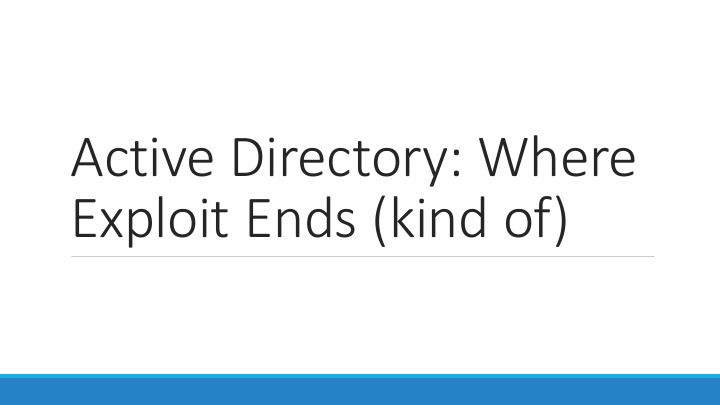



Active Directory: Where Exploit Ends (kind of)
Ar Aravind Prakash Security Analyst at Lucideus Works mostly in Infrastructure security. Passionate about offensive security. CRTE and CRTP certified. Member of DEF CON Trivandrum (https://dc0471.org), Part-time volunteer at the Red Team Village community (https://redteamvillage.org). Spoken at c0c0n international conference and DEFCON Trivandrum Meetup.
Disclaimer Opinions expressed are solely my own and do not express the views or opinions of my employer.
What Active Directory? Active Directory is a directory service developed by Microsoft for Windows domain networks. It is included in most Windows Server operating systems as a set of processes and services.
Why Active Directory? Active Directory Domain Services (AD DS) are the core functions in Active Directory that manage users and computers and allow sysadmins to organize the data into logical hierarchies. Make admins happy.
Why is it insecure?(Most cases) To much trust in a single product Misconfiguration Making it too easier to use
To much trust in a single product “We have an EDR” or “We have anti - virus software” EDR is not your one stop solution to every problem. Most EDR analyse the payload if it touches the disk. What is our payload doesn’t need to touch the disk?
We can do in-memory execution for powershell scripts or even windows executable’s. But what if powershell is disabled? Most of the time powershell restriction bypass is very simple Or We can use powershell with out powershell.exe
Domain enumeration Powerview light weight and does not create that much of a traffic. Bloodhound can enumerate all the things at once. Will create a lot noise. With these tools we can have understanding of domain, once we have valid domain credential.
Misconfiguration Weak Account policies Password in the user description High value users with a service principle names Unnecessary permissions to normal user or groups Lack of network segmentation
Weak Account policies
Start doing password spray. And we end with password hits like Welcome123! company123
High value users with a service principle names • Any user can request for a service ticket. • In current scenario, ticket will be encrypted with administrator password. • We can use hashcat to crack the ticket and get the password
Making it too easier to use Giving too much privilege for a service or user When a vendor says, “ we need domain admin credentials to run the product that will make the company secure ”. To give a user domain admin permissions to fix a problem that the team cannot find a solution to. After that forget to remove those permission.
Exploits released in 2020 Netlogon Elevation of Privilege Vulnerability Windows DNS Server Remote Code Execution.
Best practices Patch your servers regularly. Strong account policy Enable MFA (For both internal and external access) Audit ACL, Groups and Permissions weekly or monthly Create a non admin account for domain admin user for day to day job. Implement a zero trust network Monitor the event logs and look for suspicious patterns
Q&A will be happening at discord. Please join in with https://dc0471.org/discord
Thank You Twitter: a6avind_
Recommend
More recommend